Rhoda was the sixth and youngest child of James and Tamar Moss. Her grandfather Joseph Moss recorded in his diary on 8th September 1868 that ‘Tamah Wife of Mr James Moss gave birth to a daughter and they called her name Rhoda.’ She was born in Horsley Woodhouse, Derbyshire, and baptised a year later on 5th December 1869 at St Clement’s Church in Horsley. She was baptised together with her cousins Elizabeth Turner, and John and Mary Clarke.

Tragedy struck the family on 25th November 1872 when Rhoda’s mother died from tuberculosis at the age of 33; seven months later Rhoda’s father died age 42. With both parents dead, the children were split up and went to live with various relatives. Rhoda, then only four years old, was taken in and raised by her mother’s sister Fanny Scott and her husband Jim, who lived in the same row of cottages at Horsley Woodhouse. It was said of Fanny and Jim Scott that “If ever anyone will get to heaven, it will be Aunt Fanny and Uncle Jim Scott – such good, kind people they were.” 1
By 1891, having left school, Rhoda was working as a domestic servant for Samuel Tomlinson, a schoolmaster, living at Vernon House in Radcliff on Trent, Nottinghamshire. Rhoda’s sister Mary had emigrated to the United States in 1886 and Rhoda would soon follow.
The story of Rhoda’s departure from England, passed down through the family, was recalled by one of her grandchildren: ‘Rhoda found it too difficult to say goodbye to [her] Aunt Fanny Scott. Aunt Fanny did part-time cooking for Vicar and Mrs Waldy (first vicar of Horsley Woodhouse). The vicarage was less than a quarter of a mile away. When Aunt Fanny left for the vicarage, Rhoda was digging in the garden; when she returned, the spade was standing in the earth, and Rhoda was gone to Coxbench Station on her way to Liverpool, never to see them again.’ 1
On her way, Rhoda visited her sister Fanny (known as ‘Frances’) before leaving for the US. Fanny is thought to have been living at Birkenhead; in 1892 she married Thomas Samuel Polly and by 1911 they were living at Spotland, north of Manchester. ‘Fanny wanted to send a present along for [her sister] Mary in America.’ 1
Holding ticket number 24747, ‘Rhoda sailed steerage on the SS Servia – Cunard Line Steamship, departing from Liverpool 29th April 1892 with a stop at Queenstown, Ireland...the SS Servia arrived at port New York, 9th May 1892 (11 days). This was the fourth crossing of the Servia in 1892 [with] 1,189 passengers aboard. Rhoda was passenger 483 on page 11...Rhoda is listed as age 22, female, spinster, native country: England, No. 5 Std. Amidshp., destination Minnesota, one piece of luggage. There were seven immigrant ships arriving at New York that day.’ 1
‘The Statue of Liberty was only six years old when Rhoda arrived at Ellis Island. She came by train to Pomroy, Iowa (end of railroad west) and then on up to Windom for a happy reunion with her sister, Mary. There was an English settlement at Windom.’ 1
‘Rhoda did housework for the King family first. She was a beautiful seamstress and also did this for a living. She attended Breck School (Episcopal) at Wilder to learn American ways.’ 1
In Windom, Cottonwood County, Minnesota, Rhoda met Edgar Haeg Stedman, who she married on 9th March 1896 at the local United Methodist Church.
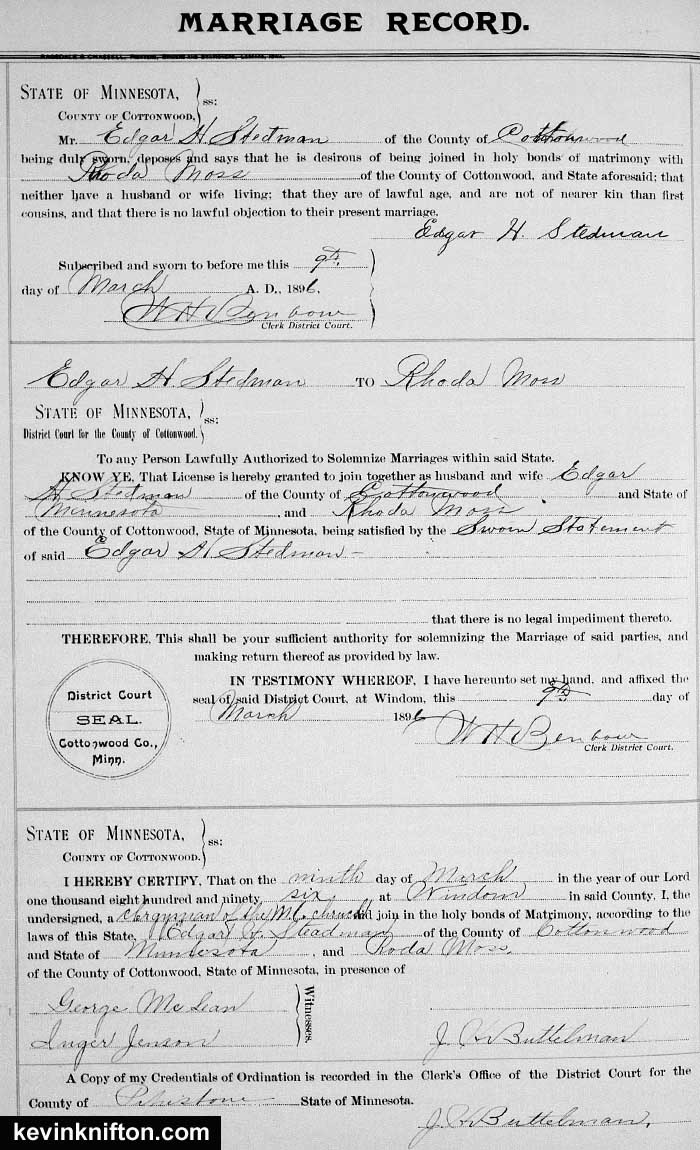
Edgar Haeg Stedman was born on 18th November 1871 in Windom, the son of Squire B. Stedman and his wife Angeline Houghton (née Thomas). After some success in agriculture in Goodhue County, Minnesota, Squire B. Stedman moved to Cottonwood in 1869, and as well as serving as sheriff for the county from 1874 to 1887, he was chairman of the Board of County Commissioners, and postmaster of Windom. The family home was said to be ‘a fine residence in the village’.
Aged 7 at the time of the 1880 US census, Edgar was recorded as being ‘at school’, and by 1895 he was working as a labourer. ‘Edgar worked for a man named Greyling in German Township who taught him German songs. Edgar liked to sing and also played the violin. He worked also in the brickyard at Bingham Lake nearby. He was a lover of horses.’ 1
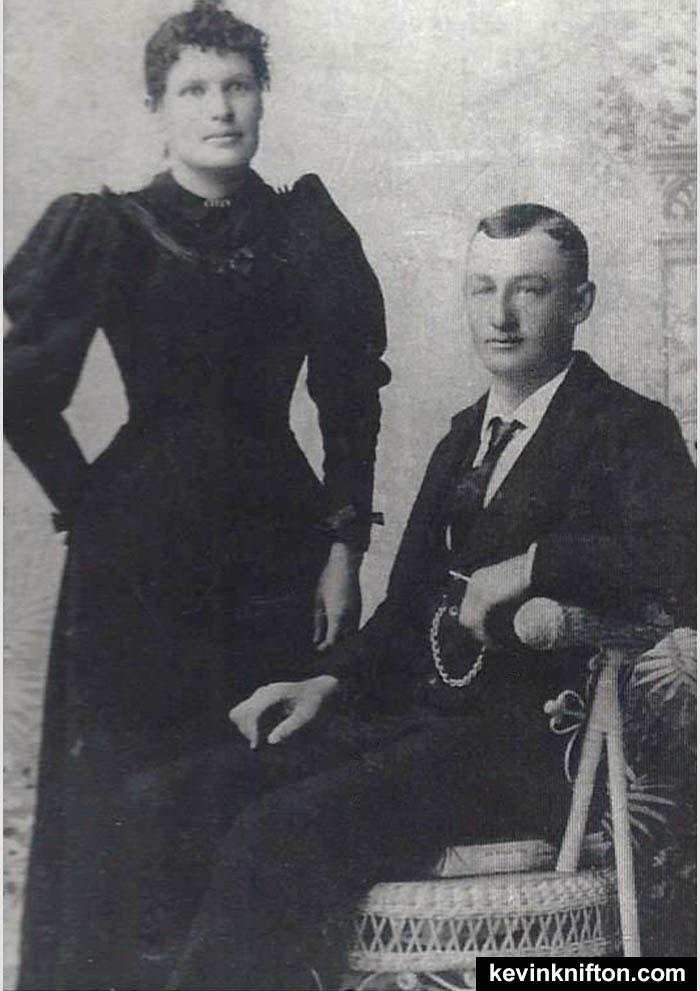 Edgar Haeg and Rhoda Stedman, circa 1896
Edgar Haeg and Rhoda Stedman, circa 1896
Within six weeks of their marriage, Rhoda and Edgar’s first child, Harold Edgar, was born in Windom on 17th April 1896. ‘He was a frail baby not expected to live at first (according to a letter written by Jim Scott from England (August 1896). They moved to a farm near Windom which belonged to [Rhoda’s sister] Mary and [her husband] Fred Fryer. Here Myrtle Evaulette was born on 8th October 1897. A tornado that fall blew down all the buildings except the house. It blew grain stacks along the river and killed all the pigs – called Gallagher Cyclone – still remembered in Windom area. Arthur Stedman (Edgar’s brother) bought a farm near Grogan and Edgar and Rhoda moved there.’ 1 Here Edgar managed his brother’s farm.
At Grogan, Rhoda and Edgar ‘were active in the community and Sunday school. Here Irene was born on 4th June 1899 - she remembered the great oxen teams and the men cracking whips when they dug the “bull ditch” (for drainage) nearby and how it rained so much that Buffalo Bill couldn’t do his show at the old St James fairgrounds and how very disappointed they were. Myrt remembered how her mother loved to hear the bells ring when they’d come to St. James – she missed the bells of England. In 1909 they moved north to Foxhome on a hay farm. Here Francis Harriet was born on 28th April 1910. After two years, they moved back to Windom and lived in a house by the river across from the dam’. 1 The move to Windom in November 1910 followed drought and crop failure, and saw Edgar swap farming for work at a construction company.
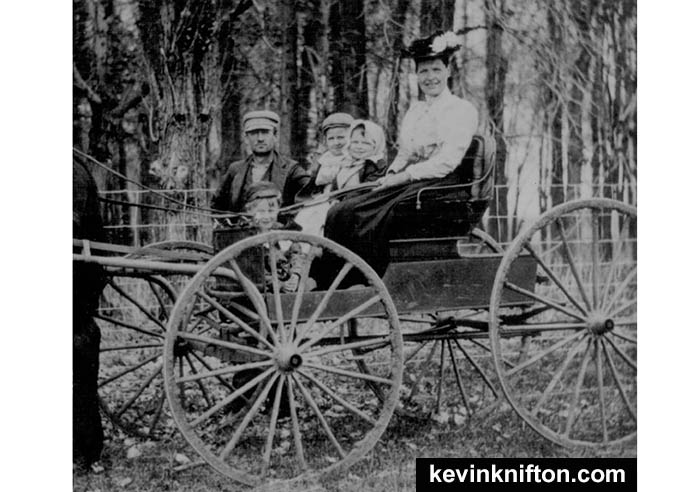 Edgar, Harold, Myrtle, and Rhoda on the way to Sunday School, cira 1905
Edgar, Harold, Myrtle, and Rhoda on the way to Sunday School, cira 1905
On 24th May 1911, between 5 and 6 p.m., Edgar was part of a group of men unloading steel beams from a railroad car for a new building in Windom. A local newspaper reported that ‘it appeared to all as though while helping push the steel from the car Edgar’s mitten caught on the steel rail [steel beam], throwing him off his balance and causing him to fall over the side of the car. The steel followed him and before he could regain his feet it was on him, striking him on the left side, fracturing the bones of the jaw and arm and causing internal injuries.’ 2 ‘An auto was called and he was rushed to the hospital at once where everything possible was done for him’. 3 ‘For a time after the accident it was thought that there was some hope, but as the internal injuries developed this hope faded and it was realised that nothing could be done’. 2 His daughter Irene ‘remembered how they had stopped by after school and talked to him shortly before it happened’. 1 Edgar died around 9 a.m. the following day.
Edgar was buried on 27th May at Lakeview Cemetery in Windom. He was remembered as ‘a kind and quiet man...he was brought up to be a gentleman with proper manners – the “New England” influence of his mother, Angeline’. 1
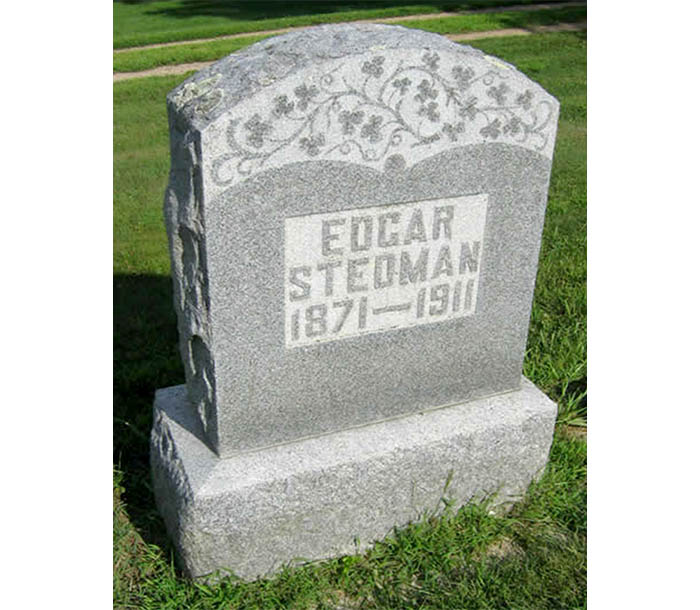
‘Rhoda bought a house on the river with the $2,000 insurance left to her’. 1 She raised her four children, who were aged 1, 11, 13, and 15 when their father died, with the help of Edgar’s mother Angeline, and his brother Frank, who both lived nearby.
In January 1920, the family were still living at River Road, Windom, and while ‘none’ is recorded under Rhoda’s occupation, the census return shows her son Harold was working as a clerk in a store, and her daughter Myrtle was working as a school teacher. Irene had married in 1919 and was no longer living at the family home.
When both her daughters Myrtle and Irene had married and moved to Watonwan County, Rhoda stayed at Windom, but visited them frequently. Her daughter Frances continued to live with Rhoda.
In the summer of 1926, Rhoda moved to St James to live with her daughter Irene Ludvigson and her family. However, shortly afterwards Rhoda had some teeth extracted, following which abscesses formed ‘from which poison extended to the entire system’. 4 It is likely that the abscesses were not treated quickly; sepsis set-in, and Rhoda died at Madelia Hospital on 25th July 1926 aged 57.
Funeral services were held on 28th July at the Ludvigson farm at 1 p.m., and at the Episcopal church in Windom later in the afternoon, following which Rhoda was buried at Lakeview Cemetery, Windom. A local newspaper report noted that ‘Mrs. Stedman was a well known character in Windom and community, and also in this neighbourhood, and her absence will be mourned by many.’ 5
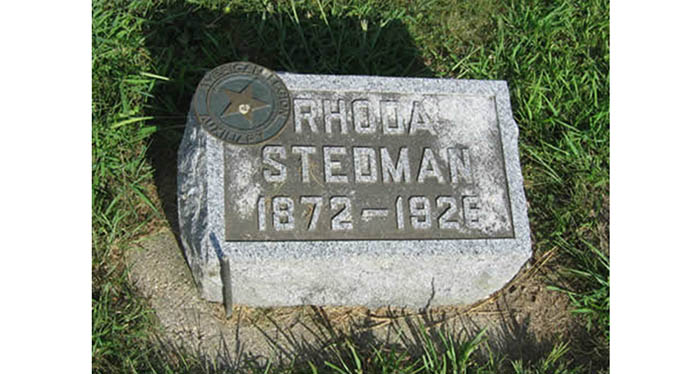 Rhoda’s grave marker includes the American Legion Auxiliary star, recognising her contribution during the First World War
Rhoda’s grave marker includes the American Legion Auxiliary star, recognising her contribution during the First World War
It is said that Rhoda thought that she was born on 5th September 1872,1 which is also the year shown on her memorial. On the 1900 US census her month and year of birth was recorded as September 1872, and her age recorded on the 1910 and 1920 census returns both tie to her being born in 1872. However, the UK census returns all indicate that she was born in 1868, including the 1891 return which would have been completed from information provded by Rhoda herself. Perhaps after arriving in the US Rhoda decided to be four years younger than she really was, and not three years older than the man she married.
I leave the last words to her granddaughter who wrote of Rhoda: ‘She loved to enter foods and handiwork at the fair...she loved to a watch a flame, it was said. Myrtie said Rhoda believed that it was 2000 years from Adam and Eve’s fall to the great flood and 2000 years from the flood to the crucifixion and it would be 2000 years until the second coming of Christ.’ 1
Rhoda Stedman (née Moss) was my first cousin four times removed.
1 Phyllis Ione Panzer (née Ludvigson) 1922-1993, ‘Stedman-Moss’ booklet (1982)
2 ‘Bad accident ends fatally’, Cottonwood County Citizen, 31st May 1911
3 ‘Heart rending accident’, The Windom Reporter, 26th May 1911
4 ‘Mrs. Edgar Stedman dies at Madelia’, Cottonwood County Citizen, July 1926
5 ‘Mrs. Rhoda Stedman dies at Hospital’, Madelia Times Messenger, 30th July 1926